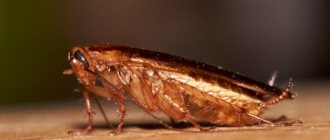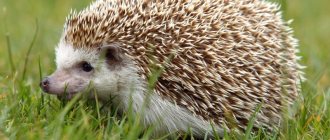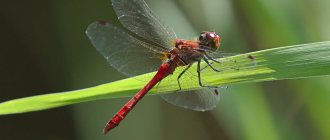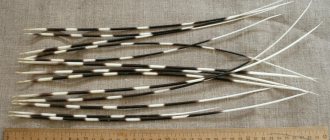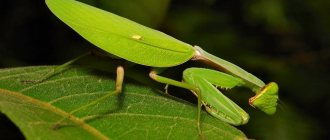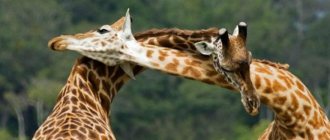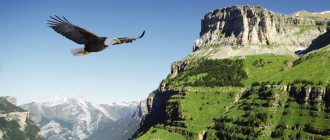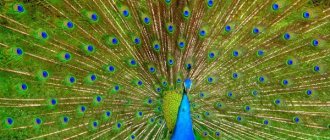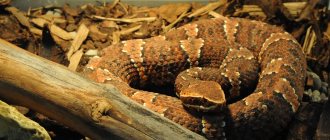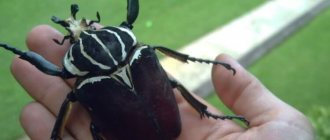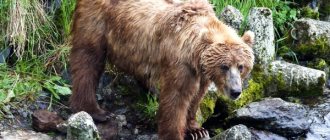- Wild animals
- >>
- Insects
Locusts are one of the most dangerous insects for the national economy. The pest of agricultural and wild crops is widespread throughout the planet. Once upon a time, in ancient times, locust raids not only destroyed crops, but could lead to starvation of an entire people. A single individual is completely harmless, but when it joins the ranks of a flock, it easily destroys all crops in its path.
WHAT DOES IT EAT?
Locusts usually live on the leaves and flowers of green plants. They use their strong upper mandibles to gnaw leaves, and use their smaller, weaker mandibles to crush them.
Since the locusts' mandibles move from side to side, the insects usually sit in the center of the leaf, on its longitudinal axis, and gnaw the leaf from edge to edge. Only a few species of true locusts feed exclusively on grass. The food for most locust species is the leaves of perennial plants, shrubs and trees. Some species of locusts can even feed on poisonous plants that other insects and animals do not eat.
Concentrating in their body, the poison provides insects with protection from enemies, since they themselves become poisonous. These locusts have bright colors, which warns of their inedibility.
What plants does it affect?
The pest is unpretentious in food , it eats the ground parts of vegetable plants, cereals, melons, attacks orchards, berry fields, wild trees, not disdaining reed plants.
Leaves, stems, shoots, even the bark of young trees serve as food .
You can learn more about the taste preferences of the merciless insect in the section devoted to its nutrition.
Interesting ! The older an insect gets, the more varied the food it eats becomes. Seasoned individuals are practically omnivorous.
SELF-DEFENSE
Many species of locusts that live in the humid tropics have warning colors. Bright or contrasting colors in which their body or wings are painted warn that the insect is poisonous. The body of such locusts contains poison that accumulates from the plants they feed on. If you touch such an insect, it emits foam that tastes and smells unpleasant.
Other types of locusts that do not have “chemical weapons” usually come in camouflage colors. The color of insects varies depending on their habitat, so the color of many of them is similar to leaves, blades of grass or pebbles. Some Central European locust species are able to blend almost completely into the background that surrounds them, making them almost impossible to notice. If such an insect is frightened, it immediately flies away, and before landing and becoming “invisible” again, it opens bright blue or red wings that scare away the enemy.
What does an insect look like?
Locusts, a group of locusts, are a fairly large pest, 3 cm long and resembling a grasshopper.
Its elongated body is covered on the sides by hard elytra, often colored to match the area in which the insect lives. The color of individuals can be brown, yellowish or green .
The female has an ovipositor in the form of a pointed spike at the end of her body.
Interesting ! The color of locusts is camouflage. It is different even among closely related insects and depends not only on the type of pest, but also on the palette of the environment, the nature of nutrition, and humidity.
In the Asian locust, for example, even the gregarious and solitary forms have different appearances.
LIFESTYLE
Locusts inhabit all those regions where there are at least a small number of plants. Only an ignorant person can claim that these insects most often live in meadows and fields. The most beautiful types of locusts are found in tropical rainforests. They even live in the mountains at an altitude of up to 6,000 m above sea level. And although locusts prefer green plants, there are species that inhabit semi-deserts and even deserts. Locusts are very voracious and damage crops. Many species - those that live in mountainous areas - do not have wings and therefore move by jumping. Only 60 of the 10,000 species of true locusts are found in Central Europe.
Land protection
Surprisingly, locusts still cause great damage to humans today. In the article dedicated to the pest, you can read about how to stop attacks of its various types.
So, we have described a dangerous agricultural pest - the locust, photographs of which you can see above.
The locust is an insect that unites several species and represents the true locust family. Another name for the species is locusts.
Locusts usually form giant swarms of several million individuals. The damage this type of insect causes to crops is incomparable. Locusts can destroy all plants in their path.
Information about these insects is reflected in the Bible; chroniclers mentioned them in their works. Locust plagues have always been a universal disaster. Countless hordes of these insects destroyed the crops, which inevitably led to mass starvation. However, the appearance of the insect does not correspond to the terrible consequences they cause. It is interesting that some types of locusts have been eaten by people for a long time.
REPRODUCTION
Mating of locusts can last up to several hours. Almost immediately after mating, the female lays her eggs, usually burying them in the ground. The female's ovipositor is very elastic and can almost double in length. This allows her to lay eggs deep enough into the ground. Each portion of eggs is enveloped in a special foamy liquid, which, when solidified, forms a kind of capsule. The time required for embryo development depends on temperature and climate. Development of the embryos begins immediately after the female lays her eggs. In species living in regions with cold climates, the development of embryos lasts longer, until the onset of cold weather. Then it stops and resumes only in the spring, when warming comes. In warm countries, worm-like larvae hatch after a short time. After the first molt, they become similar to adults, they just do not have formed wings. After this, the larva molts another 4-5 times. Each time its size increases, and at the same time the antennae and wing rudiments gradually lengthen.
Differences from grasshopper
To an uninformed person, locusts may look like grasshoppers. However, it has considerable differences: the first belongs to the locust family, suborder of the short-whiskered ones, the second belongs to the grasshopper family, suborder of the long-whiskered ones. Other differences:
- The grasshopper has longer whiskers and legs.
- The grasshopper is a predatory insect, the locust is a herbivore. However, there are times when locusts can eat a weakened fellow.
- The locust is active during the day, the grasshopper at night.
- The locust causes enormous damage to agriculture, while the grasshopper is absolutely harmless.
- Locusts lay eggs in the soil or leaves. Grasshoppers lay eggs in the bark of trees or in the stems of plants.
FEATURES OF THE DEVICE
All types of locusts produce a characteristic “chirping” sound. This peculiar “singing” of insects brings to mind for many people the image of a flowering meadow on a hot summer day. The sound apparatus of locusts is located on the thighs of the hind legs and elytra. Tubercles stretch along the inner surface of the thigh, and one of the veins of the elytra is thicker than the others. Locusts make sounds by quickly moving their hips, with the tubercles touching the vein. Because the tubercles are uneven, the result is a staccato chirping sound. In most locust species, both males and females chirp.
INTERESTING FACTS, INFORMATION
- There are many tropical locust species that do not chirp.
- Some species of locusts cover a distance of 200 times their body length in one jump.
- The bodies of true locusts can have a wide variety of colors and color variations. In addition, there are striped, spotted and speckled insects.
- Among locusts living in Europe, the chirping of individual species is so different that the females “recognize” the male of their species by their “voice.”
- One of the largest locust species is Tropidacris cristatus, which is native to Costa Rica. One ornithologist mistook this locust for an outlandish bird and caught it for display in a zoological museum.
Nutrition
The insect cannot be called picky. It can feed on both wild and agricultural crops.
The locust is a vegetarian, and its daily diet can exceed its own body weight by 2 times. A flock can destroy both a field sown by a person and harvested straw.
And during the long flight of the locust, it can even eat its own relative, thereby replenishing the lack of water and nutrients.
CHARACTERISTIC FEATURES OF LOCUSTS
A characteristic feature of locusts is the peculiar structure of their hind legs. They allow insects to jump long distances. Like grasshoppers and crickets, locusts are excellent musicians.
— Habitat of true locusts
WHERE DOES IT LIVE?
Locusts are numerous throughout the world, often living in areas with rich vegetation. They are also found in semi-deserts.
PROTECTION AND PRESERVATION
True locusts are only threatened with extinction where their habitats are destroyed, especially in tropical rain forest areas. Some species are considered serious pests.
Hordes of locusts hit the southern regions of Russia. Video (00:02:52)
In the south of Russia, all efforts are being devoted to the fight against locusts. There are more and more invasive insects; crops are already suffering from them in several regions. For example, in the Stavropol region, the current migration of giant grasshoppers is the largest in several years.
The population is so large that it is impossible even to simply walk along the road without stepping on an insect. Now these locusts are about three weeks old, and they can travel up to 15 kilometers in a day. And in a few days their wings will grow and this distance will increase to 50 kilometers.
In the eastern part of the region, where the Stavropol region borders on the steppes of Dagestan and Kalmykia, most of the land of the Levokomsky district is allocated for pastures. That's why these fields are never plowed. The locusts, which lay their larvae in the ground, reproduce very actively and begin to move to where there is more food - to the west.
Lifespan
Almost everyone knows what a wasp looks like, but few people know how long they live. Let's start with the fact that the main ones in the hierarchy of wasps are females.
Males are needed only to fertilize females, thereby producing new offspring.
After the fertilization process, the male wasp lives very briefly, and therefore, on average, their life cycle is reduced to 2-3 weeks.
On the other hand, there are females who are engaged in construction, searching for food, protecting offspring, and actually breeding offspring.
However, not everyone can do the latter, because only some of the females can be fertilized, which is why most of the females are engaged in socially useful work - construction, searching for food, feeding offspring and protecting them.
In our region, where there are distinct seasons, including a fairly cold winter, wasps usually do not live more than a year.
Moreover, only queen wasps usually manage to live for a year, while the life cycle of worker wasps is limited to 2 months.
HORROR! LOCUST ATTACK IN STAVROPOL. THIS HAS NOT HAPPENED FOR 30 YEARS / Life life TV. Video (00:03:10)
An invasion that is gaining catastrophe proportions every day! The Stavropol region is being attacked by hordes of locusts. The fight is going on both on the ground and from the air, but chemicals cannot resist the giant swarms of pests that devour hectares of crops in their path. There has not been such migration of insects in the region for the last 30 years. There are so many locusts that it dazzles your eyes! Insects have been plaguing the Stavropol region for several days now. And if the townspeople jokingly fight them with slippers, then in the villages the pests will make you cry.
Fighting methods
The locusts act mercilessly in the area. It very quickly eats up almost any planting. It is impossible to choose simple ways to combat it, because it spreads with lightning speed.
Locusts are often confused with grasshoppers, so they do not begin timely control. But in such situations, delay can cost the harvest.
Mechanical method. In the early stages, you can manually collect adults and larvae from the ground. This is quite complicated and will take time, effective only in the early stages.
Digging . If pests are noticed, before planting or after harvesting, you need to dig up the soil and add special solutions against pests.
Burning out . If there is no risk of setting fire to outbuildings, you can use fire. The remains of the plantings are burned out and the larvae die. You can enhance the effect if you sprinkle the soil with peat or straw.
Chemistry . There are a variety of drugs, and you can choose the right ones on the market. But you should understand that these drugs are harmful to plantings. They must be used carefully, without excess.
DANGEROUS LOCUST. GIANT LOCUST EATING. Video (00:02:10)
DANGEROUS LOCUST. GIANT LOCUST EATING. Locust invasion. Giant locust. Locusts eat the crops. Locusts are arthropods, class - insects, locust family. Locusts usually live on roadsides. The giant locust is a larger type of grasshopper. Dangerous Locusts gather in huge swarms, destroying all plants, These are hunger games. Locusts are dangerous. There are swarms of locusts of up to 40 billion individuals. The locust's favorite food is cereals. Due to lack of food, locusts eat all vegetation. The enemies of locusts and grasshoppers are starlings, storks, and larks. In some countries, locusts are eaten, cooked in oil, and locusts are a delicacy. Locusts gather in swarms - migratory locusts.
Lifestyle and habitat
A distinctive feature of the locust is its ability to both live alone and gather in giant communities. If an individual is solitary, it behaves quite calmly, is sedentary and not voracious. Destructive consequences from its presence are usually not observed.
When food disappears, insects try to lay as many eggs as possible, from which gregarious individuals hatch, ready to move across vast spaces. These offspring are larger, and their wings are better adapted for long flights. Giant swarms of locusts sometimes contain up to half a billion individuals. Such flocks have amazing mobility and interact as a single organism.
It is believed that the signal for mass laying of eggs may be a lack of organic substances and amino acids in the body of individuals due to insufficient food in dry years.
